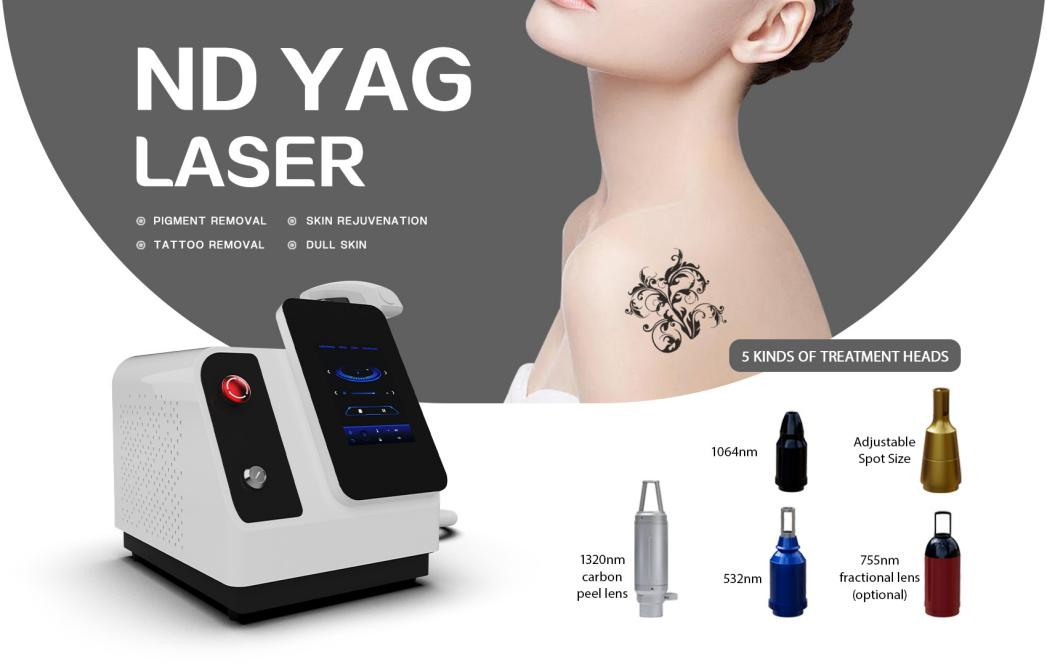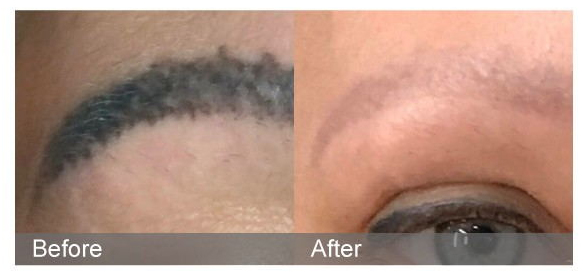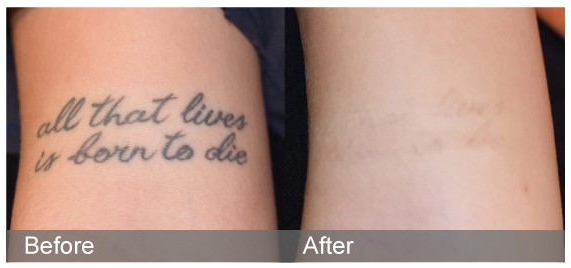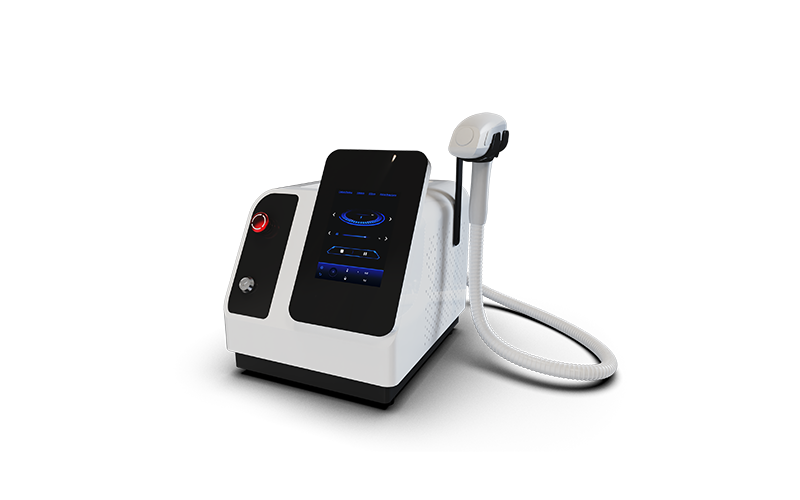 Tattoos, as an ancient form of body art, have had a demand for removing since ancient times. From early traumatic methods such as physical grinding and chemical corrosion, to the current laser technology guided by the theory of selective photothermal effects, the field of tattoo removal has undergone revolutionary progress. Among various types of lasers, neodymium doped yttrium aluminum garnet laser, also known as Nd: YAG laser, has become one of the gold standards for tattoo removal, especially professional dark tattoo removal, due to its unique physical properties.
Tattoos, as an ancient form of body art, have had a demand for removing since ancient times. From early traumatic methods such as physical grinding and chemical corrosion, to the current laser technology guided by the theory of selective photothermal effects, the field of tattoo removal has undergone revolutionary progress. Among various types of lasers, neodymium doped yttrium aluminum garnet laser, also known as Nd: YAG laser, has become one of the gold standards for tattoo removal, especially professional dark tattoo removal, due to its unique physical properties.
1.Why is ND: YAG Laser Known As the Gold Standard of Eyebrow Tattoo Removal?
To understand whether ND: YAG laser is good or not, we first need to know why it can remove pigments from the skin.
1.1 Scientific Basis and Mechanism of Nd: YAG Laser For Tattoo Removal
You can imagine the pigment particles of eyebrow tattooing as small stones scattered deep in the skin. ND: YAG laser emits a specific wavelength of laser beam that can penetrate the surface of the skin without causing excessive damage. Its target is those pigment small stones. Laser energy is instantly absorbed by pigments, producing explosive effects that shatter large blocks of pigments into extremely small powders.
Next, it’s time for your body’s own cleansing system – immune cells (macrophages) – to appear. They will act like small cleaners, gradually devouring the crushed pigment powder and excreting it out of the body through the lymphatic metabolic system. This process is not completed in one go, it needs to be carried out in several stages according to the skin’s metabolic cycle, and the pigments are gradually removed layer by layer.
1.2 Unique advantages of ND: YAG: why Is It Particularly Suitable for Eyebrow Removal?
There are many laser devices on the market, but the reason why ND: YAG is highly regarded is its unique wavelength (usually 1064nm and 532nm).
- Deep penetration power, more adept at dealing with blue melanin: The 1064nm long wavelength has stronger penetration power on skin tissue, effectively reaching the dermis layer where eyebrow pigments are located, especially adept at dealing with dark pigments such as black and blue black. This is exactly the color used in most traditional eyebrow tattooing.
- Relatively safe and more compatible with skin tone: Compared to some short wavelength lasers, ND: YAG lasers have a relatively lower absorption rate of melanin, which means that they cause less damage to normal skin during treatment, and the risk of causing blisters, scars, or depigmentation is relatively reduced. For Asians with yellowish skin tone, this is a very important safety consideration.
- Variable wavelength for complex situations: Advanced ND: YAG eyebrow removal machines are typically equipped with a 532nm green light mode, specifically designed to remove light colored pigments such as red and brown. This is very helpful for cleaning modern eyebrow patterns that use multi-color materials or for modifying red base eyebrows that have failed.
2.Real Experience: What is the Process of Laser Eyebrow Tattoo Removal?
After understanding the principle, you may be more concerned about how the actual operation is carried out. This process can be summarized as a trilogy of “consultation-treatment-repair”.
2.1 Before Treatment: Professional Consultation and Skin Assessment are the Key First Steps
Never skip this step. A responsible doctor or therapist will first carefully examine your eyebrows: the color of the pigment, the depth of deposition, the thickness and health of the skin, and even the age when you first tattooed your eyebrows (the pigment composition and treatment methods of old-fashioned and new-style semi permanent eyebrow tattoos are different). They will develop personalized treatment plans and expected outcomes based on your specific situation, and honestly inform you of the approximate number of times needed (usually 3-6 times, with an interval of 6-8 weeks between each time).
2.2 During Treatment: Brief Stabbing Pain and Immediate Response
At the beginning of the treatment, you will wear goggles. The operator will aim the laser handle at your eyebrow area and emit laser. The feeling of most people is that every laser is like being lightly splashed with hot oil or a rubber band bouncing onto the skin, accompanied by a “pop” sound.
The pain is within an acceptable range. If you are particularly afraid of pain, you can apply surface anesthesia cream in advance. After treatment, the eyebrow area usually immediately turns red and slightly edematous. The shattered pigment may appear darker in color or appear as small gray dots, which is a normal immediate response.
2.3 After Treatment: Crucial Repair Period
Post treatment care is directly related to effectiveness and safety. You need to follow strict medical advice: keep the wound dry and clean, and never use your hands to scratch the scab during the scab formation period (about 3-7 days), let them fall off naturally.
Strict sun protection is crucial because newborn skin is very delicate and UV rays can easily cause pigmentation. At the same time, the diet should be light and avoid spicy and stimulating foods as well as volatile substances.
3.Limitations and Potential Risks of ND: YAG Laser
No technology is perfect, and ND: YAG laser is no exception. Realizing its limitations clearly is the key to avoiding disappointment and risk.
3.1 Obstacles that Are Difficult to Overcome: Dealing with Colorful Eyebrow Tattoos
This is the main shortcoming of ND: YAG laser. The absorption efficiency of 1064nm wavelength for colored eyebrows such as red, yellow, and green is very low, and the effect is minimal or even ineffective.
For these colored pigments, they usually need to be processed with lasers of other wavelengths (such as 532nm, 755nm, etc.). Therefore, if your eyebrow tattoo is colored, a simple ND: YAG laser may not be a complete solution.
3.2 Discomfort During Treatment and Postoperative Reactions
Receiving laser treatment is not without sensation, most people describe it as a tingling sensation similar to rubber band bouncing on the skin. After surgery, there may be slight redness, swelling, and even small white blisters in the treatment area, which is a normal inflammatory response and usually subsides within a few days. The most important thing to pay attention to is postoperative care. Sunscreen is crucial, otherwise it may cause pigmentation and even darken the skin.
3.3 Expectancy Management: Why Do We Need Multiple Treatments?
Eyebrow removal is not something that can be achieved overnight. A single treatment can only remove some pigments, usually requiring 5-10 or even more treatments, with an interval of 6-8 weeks between each treatment, to achieve the desired effect. The ink composition, depth, color, and personal metabolic rate of eyebrow tattooing can all affect the duration of the treatment. Having the illusion of ‘one-time eradication’ will only bring unnecessary frustration.
3.4 Answering Common Doubts
“Will it harm my hair follicles?” The professional ND: YAG laser targets pigment particles and has little effect on hair follicles that do not contain a large amount of pigment. But during the treatment process, some hair may temporarily fall off, and most will regrow with the metabolic cycle. Choosing experienced operators can maximize the protection of hair follicles.
“Why are others more effective than me?” The effect varies from person to person. Old style, dark colored, and large grained eyebrows are easier to remove. However, some modern pigments containing iron oxides (which are prone to turning red) may not respond well to lasers, and may even change color, requiring more complex treatment plans.


4.How to Choose Between ND: YAG and Picosecond Laser?
4.1 Technical Features of Picosecond Laser
The advantage of picosecond laser lies in its ultra short pulse time, which can crush pigments into finer powders with stronger shock waves. Theoretically, it can shorten the number of treatments and cause less thermal damage to surrounding tissues.
4.2 Rational Comparison, Rather Than Blindly Following the Trend
- For ordinary black and blue black eyebrow patterns: Mature ND: YAG technology has achieved very good results, and the cost is usually lower than picoseconds.
- For complex colors (such as red, green) or pursuit of shorter treatment duration: Picosecond lasers of specific wavelengths may have advantages.
The core lies in the equipment and the operator.
Regardless of the technology, the experience of the operating doctor and their proficiency in the equipment are far more important than the equipment itself. An experienced doctor using professional ND: YAG equipment will achieve much better results than a novice using top-notch picosecond equipment.
5.Nubaway’s ND: YAG Laser: More Professional, Better Result

5.1 Significant Therapeutic Effect and High Comfort
ND YAG Laser is a commonly used medical cosmetic laser technology that can effectively solve various skin problems and diseases. Its advantage lies in its ability to penetrate deep into the skin, achieving significant and long-lasting therapeutic effects. It can break down pigment particles into smaller units, making them easy to be absorbed and cleared by the body. At the same time, the laser can reach deep into the skin and be efficiently absorbed by melanin, greatly reducing the pain during the treatment process and providing users with the highest level of comfort experience among all similar laser products.
5.2 Safety, Reliability, and Diverse Functions
This device crushes pigment particles without causing any damage to surrounding skin tissue, effectively reducing the risk of normal tissue damage and decreasing the probability of pigment deposition, with excellent safety. In addition, the four different handles equipped on the machine make its functions extremely diverse, covering a wide range of treatment needs such as tattoo removal, improving skin dullness, skin rejuvenation, and removing acne and blackheads.





